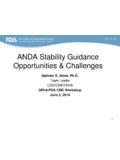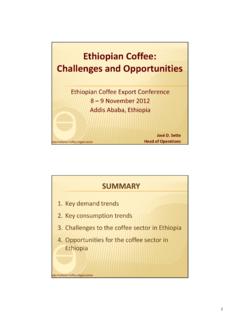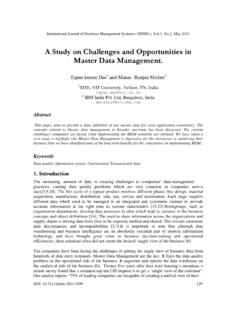Transcription of GLOBAL VALUE CHAINS: CHALLENGES, …
1 GLOBAL VALUE CHAINS: challenges , opportunities , AND IMPLICATIONS FOR POLICY OECD, WTO and World Bank Group Report prepared for submission to the G20 Trade Ministers Meeting Sydney, Australia, 19 July 2014 FOREWORD 3 GLOBAL VALUE CHAINS: challenges , opportunities , AND IMPLICATIONS FOR POLICY FOREWORD Meeting at the Saint Petersburg Summit in September 2013, the assembled leaders of the Group of Twenty noted the importance of better understanding the rapid expansion of GLOBAL VALUE chains (GVCs) and impacts of participation in GVCs for growth, industrial structure, development and job creation. Leaders welcomed the work done in 2013 by the OECD, the WTO, and the UNCTAD, and asked them to seek the views of governments and continue their research on the impact of GVCs, particularly in relation to the influence of GVCs on trade, economic growth, development, job creation and distribution of VALUE -added along GVCs.
2 Leaders also called on the OECD in cooperation with the WTO and UNCTAD to deliver a report in the first half of 2014. Subsequently, the OECD invited the World Bank Group to participate in this exercise. The present document, drawing upon the latest research, is submitted in fulfilment of that mandate. The rise of GVCs has produced a new trade-investment-services-know-how nexus, or the intertwining of trade in intermediates, the movement of capital and ideas, and demand for services to coordinate the dispersed production and distribution of goods and services. As such, GVCs are becoming increasingly influential in determining future trade and FDI patterns, as well as growth opportunities . Policy needs to respond to this new reality and promote a business environment that not only makes a country attractive for location of GVCs, but also facilitates upgrading opportunities over time.
3 The analysis stresses that GVCs do not respond to piecemeal approaches to policy change. A whole-of the-supply- chain approach is needed. Some of these policies are horizontal in nature: good infrastructure and connectivity, a business-friendly environment, flexible labour markets, access to credit, innovation and macroeconomic stability. Other policies are more targeted, such as tariffs and other trade restrictions, subsidies, local-content or export-performance requirements, and restrictions on foreign exchange. This report, together with discussions during the G20 Australian Presidency-OECD Stocktaking Seminar on GVCs that was held in Paris on 5 May 2014, highlights the following priority actions for G20 governments: Implement and ratify the WTO Trade Facilitation Agreement as quickly as possible. G20 governments should consider implementing TF measures such as streamlining customs procedures even before the ratification process is finalised at the WTO.
4 Developed countries should provide support, where possible, to developing countries as they make trade facilitation commitments that require additional technical assistance. Improve services sector efficiencies, as services are the links that forge GLOBAL VALUE chains. Reinforce the standstill commitment against protectionism and wind back any restrictive measures implemented since the crisis with a particular focus on non-tariff barriers. Address supply chain barriers, including where their removal would encourage participation by small and medium-sized enterprises. Ensure that preferential trade agreements create better business outcomes. Pursue active labour market policies and investments in education, skills and training to better match labour supply with demand and develop adequate social safety nets for those facing difficulties in adjustment.
5 It is important to stress that while open markets are crucial, alone they are insufficient. GVCs also need to be complemented with appropriate and wide-ranging policy frameworks that allow countries and firms to capitalize on their existing productive capacities and spillover benefits from foreign investment, knowledge, 4 FOREWORD GLOBAL VALUE CHAINS: challenges , opportunities , AND IMPLICATIONS FOR POLICY and innovations. These include labour market policies, social policies and competition policies as well as policies for investment in education, skills, technology and strategic infrastructure. The development dimension of GVCs will remain an important focus of our work as we move forward. GVCs offer an opportunity to integrate in the world economy at lower costs but gains from GVC participation are not automatic. Benefits of GVCs can also vary considerably depending on whether a country operates at the high or at the low end of the VALUE chain .
6 This report is a further contribution to this discussion. To fully capture the effects and implications of GVCs for developing countries, it will nevertheless be important to continue and deepen our analysis to improve our understanding and help governments to harness the benefits. We look forward to continuing to update G20 Leaders on a timely basis. TABLE OF CONTENTS 5 GLOBAL VALUE CHAINS: challenges , opportunities , AND IMPLICATIONS FOR POLICY TABLE OF CONTENTS Executive Summary .. 7 Introduction .. 10 Part I. How GVCS transform the nature of trade and trade policy .. 12 GVCs and trade in services .. 15 GVCs, jobs and wages .. 17 GVCs and developing countries .. 18 What determines countries GVC engagement? Evidence from the OECD-WTO TiVA data .. 18 Part II. Elements that facilitate or impede participation in GVCs .. 20 The diversity and capacities of firms.
7 20 Government policies that promote or retard competitiveness .. 23 Bottlenecks in infrastructure .. 28 Trade barriers .. 29 Non-tariff measures raise specific concerns for GVC participation .. 31 Part III. Domestic and international agendas to improve GVC performance .. 34 Sound public institutions can enhance trade in industries with long VALUE chains .. 35 Raising skills can facilitate knowledge-intensive participation in GVCs .. 35 GVCs and innovation .. 37 GVCs and foreign direct investment .. 39 Financial development can alleviate cash constraints and facilitate GVC participation .. 40 Adaptive product and labour market regulations can promote GVC participation .. 41 Improving logistics is key to GVC participation .. 42 Trade liberalisation at the multilateral and regional levels .. 42 Trade facilitation and aid for trade .. 44 National single-window programmes .. 47 Social and environmental policy.
8 48 Further research on 49 Bibliography .. 50 Tables Table 1. Firm characteristics and fields of public policy that affect competitiveness in GVCs .. 24 Table 2. Estimated benefits for G20 countries from trade facilitation .. 46 6 TABLE OF CONTENTS GLOBAL VALUE CHAINS: challenges , opportunities , AND IMPLICATIONS FOR POLICY Figures Figure 1. Average bilateral trade costs for goods and services, 1995=100 .. 12 Figure 2. GVC participation, 1995 and 14 Figure 3. FDI and GVC participation, developed and developing countries, 1990-2010 .. 15 Figure 4. Services VALUE -added in gross exports, % .. 16 Figure 5. Jobs in the business sector sustained by foreign final demand, 1995 and 2008 .. 17 Figure 6. Barriers firms face in entering VALUE chains: Public sector views .. 27 Figure 7. Barriers firms face in entering VALUE chains: Private sector views .. 28 Figure 8. Tariffs on the gross VALUE and the domestic VALUE -added of exports, 2009.
9 30 Figure 9. Average level of restrictiveness imposed on imports .. 31 Figure 10. Final demand developments implied that demand for high-skill labour rose across most countries over 1995-2008 .. 36 Figure 11. R&D investment in OECD and G20 economies, 2011 .. 38 Figure 12. Share of national employment under control of foreign affiliates, 2010 .. 39 Figure 13. R&D intensity in the manufacturing sector .. 40 Figure 14. Trade facilitation measures: Potential cost reduction in goods trade (%), .. 45 Boxes Box 1. Buyer-Supplier relational linkage strength of GLOBAL supply chains .. 21 Box 2. Negative lessons learned from failed industrial policies .. 26 Box 3. Trade and investment barriers: The case of LCRs affecting renewable energy .. 32 Box 4. Case studies in logistics reform: Indonesia and Morocco .. 43 EXECUTIVE SUMMARY 7 GLOBAL VALUE CHAINS: challenges , opportunities , AND IMPLICATIONS FOR POLICY EXECUTIVE SUMMARY The growth of GLOBAL VALUE chains (GVCs) has increased the interconnectedness of economies and led to a growing specialisation in specific activities and stages in VALUE chains, rather than in entire industries.
10 Over 70% of GLOBAL trade is in intermediate goods and services and in capital goods. The income created within GVCs has doubled, on average, over the last 15 years; in China, income associated with GVCs has grown six-fold. Not all firms and countries are equally involved in GVCs. Some countries participate in many, either as the host country to lead firms or as suppliers of very specific tasks, while others participate very little. These varying degrees of connectedness are determined by many considerations, some of which are fixed (such as a country s geographic location and resource endowment), while others can be shaped by public policy (such as a country s human capital, physical infrastructure, and overall investment climate). Here governments play a key role, as they may enact policies that either promote or reduce the capacities of their firms to enhance their competitiveness, attract investment, and insert themselves into GVCs.
















